Centaurus High School students explore questions about fire and visit a wildland fire station on their overnight. Written by Field Instructor Jarrod Gaut.
 Becalmed atop a hill, the group surveys a wide and snowy vista. The wind whispers hello as it heralds a frosty moisture. Clouds marshal themselves above snowy peaks and hurry towards the eastern plains. A cry pierces the wind-kissed calm: “Miss, hay un oso!” (There is a bear). Whipped to attention by the respected and feared creatures, the group of wide-ranging Centaurus High School CAP students clambers together in an excited chatter. But there is nothing to fear here; it is a sublime moment. A mother bear, her cub, and her yearling trudge out of their slumber across the steep valley. Spring has come, and has brought us the first sighting of these newly awoken friends. The bears slowly fade in and out of the trees. We had practiced focusing our vision playing Camouflage, hiding and stalking our friends to challenge their vision and their hearing. We use these skills now to follow the path of the bears, until they crest the ridge and disappear from sight.
Becalmed atop a hill, the group surveys a wide and snowy vista. The wind whispers hello as it heralds a frosty moisture. Clouds marshal themselves above snowy peaks and hurry towards the eastern plains. A cry pierces the wind-kissed calm: “Miss, hay un oso!” (There is a bear). Whipped to attention by the respected and feared creatures, the group of wide-ranging Centaurus High School CAP students clambers together in an excited chatter. But there is nothing to fear here; it is a sublime moment. A mother bear, her cub, and her yearling trudge out of their slumber across the steep valley. Spring has come, and has brought us the first sighting of these newly awoken friends. The bears slowly fade in and out of the trees. We had practiced focusing our vision playing Camouflage, hiding and stalking our friends to challenge their vision and their hearing. We use these skills now to follow the path of the bears, until they crest the ridge and disappear from sight.
 Bears are just one of the new sights and smells the class encountered at Cal-wood. Camped at the campground known as Solitude, the group found themselves at the edge of the Cal-wood Burn Scar. We could stand at the edge of the scar and look out east at the path of desolation while the green of pine needles nudged at our peripheries. Hiking at night, we could smell the ash and char. Fire is a burning question for the CHS class. How, and why, do these fires burn down our forests? And what can we do about it? Cal-wood Natural Resource Manager, Angie Busby, taught us how centuries-old fire suppression has loaded our fire-adapted forests like an explosive. We saw photos from 1909 of open, well spaced ponderosa pines, and contrasted it with the dense “dog-hair” forests of today. But we also could see how we are learning from our mistakes. With Angie, we built prescribed burn piles to re-introduce safe fires into our forest (which will be burned with supervision in the coming winter).
Bears are just one of the new sights and smells the class encountered at Cal-wood. Camped at the campground known as Solitude, the group found themselves at the edge of the Cal-wood Burn Scar. We could stand at the edge of the scar and look out east at the path of desolation while the green of pine needles nudged at our peripheries. Hiking at night, we could smell the ash and char. Fire is a burning question for the CHS class. How, and why, do these fires burn down our forests? And what can we do about it? Cal-wood Natural Resource Manager, Angie Busby, taught us how centuries-old fire suppression has loaded our fire-adapted forests like an explosive. We saw photos from 1909 of open, well spaced ponderosa pines, and contrasted it with the dense “dog-hair” forests of today. But we also could see how we are learning from our mistakes. With Angie, we built prescribed burn piles to re-introduce safe fires into our forest (which will be burned with supervision in the coming winter).
On our way up the valley, we talked with Wildland Fire Captain Ramesh Jones at the newly built Left Hand Fire Station to see how firefighters mitigate the damage of these modern raging wild fires…and we maybe got to jump into a few firetrucks, just because firetrucks are cool.

Los osos son sólo una de las nuevas vistas y olores que la clase encontró en Cal-wood. Acampados en el camping conocido como Solitude, el grupo se encontró al borde de la cicatriz del incendio de Cal-wood. Podíamos situarnos en el borde de la cicatriz y mirar hacia el este, hacia el camino de la desolación, mientras el verde de las agujas de los pinos nos rozaba la periferia. De noche, podíamos oler la ceniza y el carbón. El fuego es una cuestión candente para la clase de la CHS. ¿Cómo y por qué estos incendios queman nuestros bosques? ¿Y qué podemos hacer al respecto? La Directora de Recursos Naturales de Cal-wood, Angie Busby, nos enseñó cómo la supresión de incendios durante siglos ha cargado nuestros bosques adaptados al fuego como un explosivo. Vimos fotos de 1909 de pinos ponderosa abiertos y bien espaciados, y las contrastamos con los densos bosques de “pelo de perro” de hoy en día. Pero también pudimos ver cómo aprendemos de nuestros errores. Con Angie, construimos pilas de quema prescrita para reintroducir incendios seguros en nuestro bosque (que se quemarán con supervisión en el próximo invierno).
De camino al valle, hablamos con Ramesh Jones, capitán de bomberos forestales, en el recién construido parque de bomberos de Left Hand, para ver cómo los bomberos mitigan los daños de estos modernos incendios forestales… y quizá pudimos subirnos a algunos camiones de bomberos, porque los camiones de bomberos molan.
